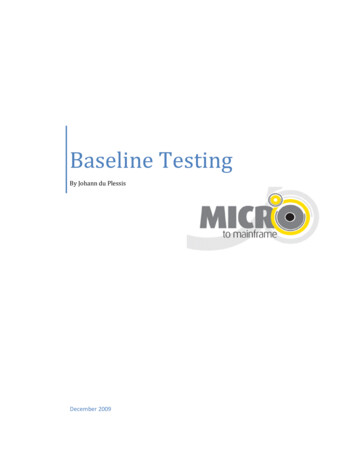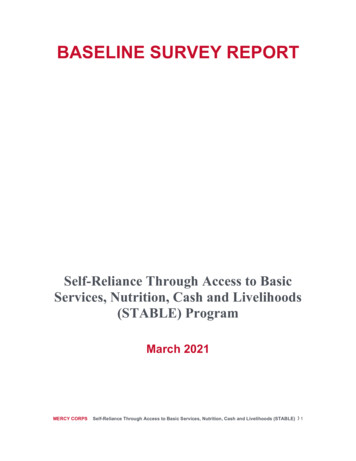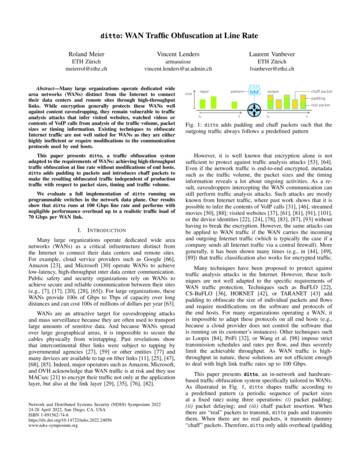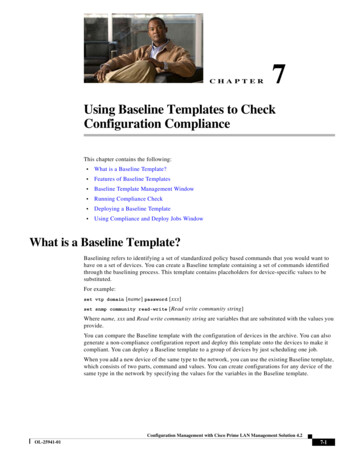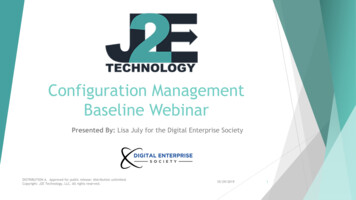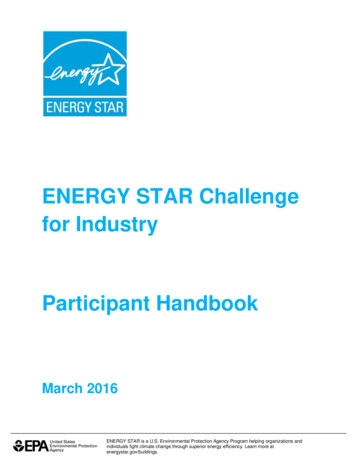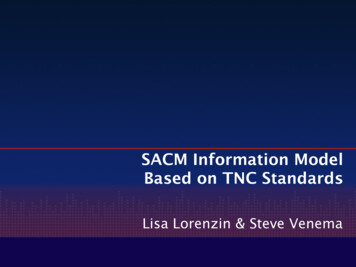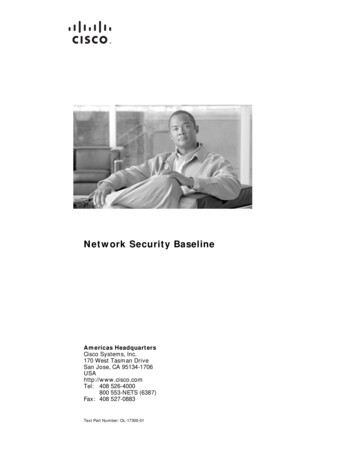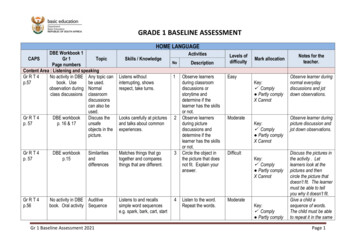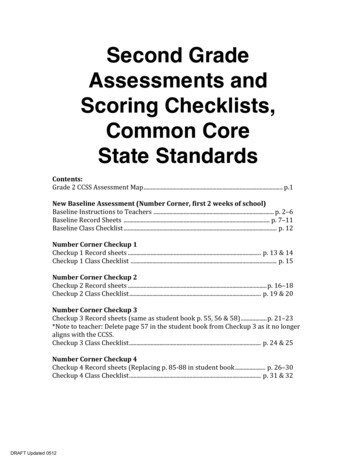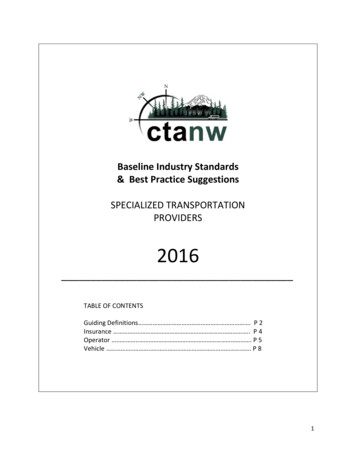
Transcription
Baseline Industry Standards& Best Practice SuggestionsSPECIALIZED TRANSPORTATIONPROVIDERS2016TABLE OF CONTENTSGuiding Definitions . P 2Insurance . . P 4Operator . . P 5Vehicle . . P 81
Background Definitions and AssumptionsSPECIAL TRANSPORTATION NEEDS - RCW – 81.66.10 (3)Excerpt – “Persons with special transportation needs” means those persons, including theirpersonal attendants, who because of physical or mental disability, income status, or age areunable to transport themselves or to purchase appropriate transportation.ADDITIONAL FACTORSCommunity Transportation Association of the Northwest recognizes the following alsocontribute to special transportation needs:- Geographic location- Availability of transportation options- Familial, custodial, guardian status – i.e. parent is transporting childrenPROVIDERS OF TRANSPORTATION TO PERSONS WITH SPECIALTRANSPORTATION NEEDSCommunity Transportation Association of the Northwest recognizes transportation options forpeople with “Special Transportation Needs” can be provided by all of the following: Publictransit, paratransit, transportation network/rideshare companies (Uber/Lyft), friends/family,neighbors, churches, community organizations, volunteers, private companies, nonprofits,senior centers, assisted living organizations, veterans’ programs, taxi companies, limousine andtown car companies, shuttles, ferries, trains, government agencies, planes, helicopters,ambulances, school buses, and private cars.Application and Development of Best Practices and StandardsA committee of transportation providers, brokers, transits, and government agenciesresearched current and existing contract regulations and incorporated the latest best practicesfrom field experience into the recommendations. It is assumed ‘Best Practices’ and ‘Standards’will evolve as the industry evolves.2
This information is designed for use by any business or organization providing “SpecializedTransportation”, with particular emphasis on businesses or organizations where transportationis a direct service or major component of the programming and where there is a financialcontract or agreement to provide the service. It designed as a “Professional Standard” that canbe adapted to meet organizational and customer/client/passenger needs.A Specialized Transportation Provider (AKA Supported MobilityTransportation Provider): Has a vehicle designed or specially enhanced to meet various mobility capacities andneeds (seating, ramps, accessible loading, etc.); Has a driver who has received training to work with various populations, including thoseliving with various abilities, mental and cognitive capacities, and those from variousbackgrounds; Has internal rules and regulations designed to promote safety; Provides Location/Destination specific options, including pick-up and drop-off; Includes up to door-to-door, door-through-door, and hand-to-hand services (above andbeyond curb-to-curb).Areas of Best Practices and Standards Insurance Operator/Drivers Vehicles and Inspections3
INSURANCEAMOUNTSBASELINE INDUSTRY STANDARDS INSURANCE TYPECARRIER RATINGBEST PRACTICE SUGGESTIONSCommercial & General Liability Policy1,000,000 Occurrence Limit2,000,000 General Aggregate LimitoBusiness Auto Liability Insurance1,000,000 Combined Single Limit (CSL) forall owned, hired, leased and non-ownedvehiclesoLoading & Unloading CoverageInsurance coverage must include Loadingand Unloading Coverage and cannot limitcoverage to a certain premises. Thisincludes “ bodily injury to any personbeing transported or assisted from theplace where there accepted for movementin an “auto” or from an “auto” to theplace where they are finally delivered ”ooo Worker’s CompensationCompliant with all applicable stateWorker’s Compensation, occupationaldisease, occupational health and safetylaws and regulations; All employee driversshall be covered under Washington Laborand Industry Policies or by private carrier. All insurance policies shall be written onan “Occurrence” or “Per Occurrence”basis. Provider shall provide, upon request,certification of the coverage requiredunder this section. B ooooooSexual Abuse andMolestation CoverageEmployment PracticesLiabilityDirectors & OfficersLiabilityFiduciary LiabilityEmployee BenefitsLiabilityCyber LiabilityCrime CoverageUninsured/UnderinsuredMotorist CoverageProperty CoverageUmbrella/Excess LiabilityA Best’s Report rating ofB , Class VII, or better,Surplus Lines insurancecompanies should have aA-, Class VII, or better.4
OPERATORSQUALIFICATIONSTRAININGBASELINE INDUSTRY STANDARDS Have a Valid Driver’s License recognizedby the States of Washington, Oregon andIdaho. Be able to operate a vehicle in accordancewith manufacturer recommendations, andall local, state and federal laws.BEST PRACTICE SUGGESTIONSoAbilities to communicatein the predominatelanguage(s) of thegeographic serviceregion, including English.oKnowledge of theGeographic Serviceregion. Have at least 5 years of driving experience. Be able to document informationaccurately, and communicate clearly onradio and in person.oHave at least 3 yearsdriving experience in theUnited States. Obtained prior to hire and annually,maintain a DMV record with: no morethan 3 moving violation convictions in thelast 3-year period; no “Driving Under theInfluence” convictions in the last 5-yearperiod; and no more than 1 at-faultaccident in the last 24-months.oHave no more than 2moving violationconvictions in a 3-yearperiod.oBe able to maintain a preemployment and annualfingerprint level CriminalBackground Check inaccordance with RCW43.43.830 and WAC388.112.0020.oChild Safety Restraint(Child Safety Seats)CDL (if applicable)Technology & DistractedDrivingHIPAA Be able to pass a pre-employmentfingerprint level background check andannual Criminal Background Check with noconvictions in accordance with RCW43.43.830 and WAC 388.112.0020. Maintain annual “Fit for Duty” certificationfrom a recognized physician or throughself-declaration. Successfully complete training in theareas of: Accident, Incident Reporting Passenger Assistance & Customer Service,including no less than: working withdisabled youth and adults; de-escalationtechniques; working with aging adults;working with populations with lowerincomes; working with people who have amental health diagnosis; and passenger-ooo5
appropriate loading and unloadingtechniques.PROFESSIONALCONDUCT &ORGANIZATIONPOLICIES Wheelchair and Mobility DeviceSecurement CPR/FIRST AID Biohazards & Blood Borne Pathogens Vehicle Evacuation Procedures, to includeFire Suppression and Client/DriverEvacuation-First Procedures Mandatory Reporting Confidentiality and Documentation Drug and Alcohol Abuse Awareness ID Badge, including name or ID number,picture and name of organization must beworn or prominently displayed in thevehicle. Adherence to drug and alcohol policieswhich include at the minimum: preemployment testing and post-accidenttesting consistent with FTA guidelines. Maintain confidentiality of passengers. Maintain smoke-free public spaces asrequired by Washington State Law. Follow Mandatory Reporting for Abuseand Neglect requirements provided byWashington State Department of Socialand Health Services, the WashingtonAdministrative Code, and the RevisedWashington Code. Adopt an Americans with Disabilities Actcompliance Service Animal Policy which isreadily available to customers, clients andpassengers.oMaintain drug andalcohol-free standards setby the Federal TransitAdministration, whichincludes random testing.oMaintain a harassmentfree environment.oProvide courteous andpolite customer service.oAdhere to professionalconduct standards,including ethicalboundaries,nondiscrimination, andcustomer service.oAdopt organizationalpolicies pertaining to:-Drug and Alcohol TestingHarassment ntReportingReporting of License6
-DOCUMENTATION Pre-employment application, fingerprintbackground check and DMV record; Copyof Driver’s License; DMV Record for allyears of employment; documentation ofpre-employment and annual backgroundchecks; Signed receipt of compliance withminimum qualifications and organizationalpolicies. Documentation of completed mandatorytrainings Documentation of pre-employment andany post-accident drug/alcohol testing Copy of ID BadgeSuspension or Revocation,or ConvictionsDriver er ComplaintProcessShared-Ride PoliciesNo-Show/CancellationPoliciesSeatbelt UsageCustomer/PassengerRights and ResponsibilitiesReasonableAccommodationsPassenger EligibilitySafety MeetingAttendanceCDL Level (if applicable)Mileage ReimbursementEmergency PreparednessPhysicalsCell phone, personalelectronic devicesMediaPassenger ComplaintMediation7
VEHICLESINSPECTIONSBASELINE INDUSTRY STANDARDS Inspections must be completed by aCertified Mechanic. Initial inspections must be completed priorto a vehicle joining the fleet. Complete inspections include thefollowing points (included in attachmentA). Complete inspections must be completedfor each vehicle periodically.BEST PRACTICE SUGGESTIONSoComplete inspections bya Certified Mechanicshould be conductedannually; Use of Mileageintervals to determineperiodic inspectionfrequency should bebased on OEMspecifications.ATTACHMENT A(This inspection should be completed on each vehicle used for specialized transportation services prior to the vehicle joining the fleet andperiodically thereafter. Each of the following must meet or exceed Manufacturer and Federal Transit Administration (FTA) guidelines*.)*Highlighted for Vehicles with Enhanced Communication or Mobility Equipment Only Body and sub frame are free of significant/substantive damage, all bolts areBODY & EXTERIORtightened and meet minimum requirements Company name, logo and vehicle number are present, visible and legible Hood, trunk and door latches are fully functioning Vehicle is clean and free of debris Springs and shock absorbers are in place and fully functional Brake system is fully operationalBRAKING SYSTEM Brake pads, rotors, lines and components meet minimum safety standards Brake pedal is firm and provides complete stops Emergency (parking) brake is completely operational, and hold vehicle withthrottle engaged Brake percentages meet minimum safety guidelines 2-way communication system is in If a camera system is in place,COMMUNICATIONplace and fully functional. Thisensure camera system is inSYSTEM &CAMERASsystem must provide continuousworking order.communication between theoperator and dispatch and beutilized in accordance RCW:46.61.667. All doors and windows are fully functional, free of cracks or damage, and areDOORS &able to be securedWINDOWS Door handles, latches and hinges are fully operational Emergency exits have clear signage and directions for useEMERGENCY EXITS Emergency exits are fully functional Emergency alarm, lighting and signs are fully functional 8
EMERGENCYSUPPLIESENGINE, EXHAUST& FLUID SYSTEMS The vehicle includes the following emergency supplies, properly stowed andoperational: Accident/Incident Report KitBio KitEmergency or caution indicators, including at least one of the following:Caution Lights, Caution Markers, Emergency Triangles and/or Flare(s)Fire Extinguisher with pin intactFirst Aid KitTraction Devices (for vehicles operating in winter or hazardous conditions)FlashlightSeat Belt CutterIce ScraperBattery and cables are fully functioning and in good repairCooling system, including radiator, hoses and fluids are operational and meetminimum safety regulationsBelts, pulleys and wheels are fully operationalMuffler and exhaust system is fully functioning and free of leaks or damageHeating and cooling systems are fully functioningAll fluids meet minimum levels, are new or replaced according tomanufacturer specificationsEmissions system is fully functionalAir intake systems and filters are fully functionalFan is functional and fan shroud is in place and free of damageAll wiring is connected, and free of damageHoses, containers and fluid vessels are free of leaks and corrosionIgnition and starting system is fully functionalIntake and acceleration system is functionalDistributor system is fully functionalFuel system meets manufacturer standards, and is functioning properly withno leaks presentFuel Cap (if applicable)Fuel tank is free of damage or leaks (any kind of fuel)Alternative fuel or after-market conversions or modifications must meetmanufacturer standards and approval from the Environmental ProtectionAgency (EPA).Air Conditioner, heater and defrost system is functional and workingSpeedometer, fluids, fuel and electrical system gauges are fully functionalHorn is functioningSwitches and controls are fully functionalInterior is clean and free of debrisFlooring and walls are free of dirt and debrisThe vehicle is scent-freeAll items are securely stowed FUEL & THROTTLESYSTEMGAUGES &OPERATORCONTROLSINTERIOR & CABINLIFTS & MOBILITYEQUIPMENT Lift, ramps, and mobility devices are fully operational, and serviced permanufacturer instructions; Lift and/or ramp is fully cycled during inspection toconfirm operations9
MIRRORS,WINDSHIELD,LIGHTING &SIGNALS SEATING &SECUREMENT STEERING SYSTEMTIRES, WHEELS,DRIVE TRAIN ANDAXELSTRANSMISSIONSYSTEM All electrical and manual components are fully functionalLoad test label or certification is clearly visibleRamps are free of any defects and fully operational.Vehicle includes at least 2 exterior side view mirrors free of scratches, cracksor debrisRear-view mirror is in place and free of cracks, scratches or debrisWindshields shall meet current state safety statues; No damage or debrisinhibiting visibility or creating a hazardWindshield wipers are in place and fully functionalAll signals, gauges and lighting are fully functional, including headlights,taillights, parking lights, emergency lights, back-up lights and alarms, interiorlighting (dome, dash and step) and exterior lightingSeats are fully secured to the floor If vehicle includes passenger andand are clean and free ofdriver restraint devicessignificant tears, holes or rips(seatbelts), devices are fullyfunctionalDriver’s seat is fully operational,and free of significant tears, cuts If vehicle has handrails, theor disrepairhandrails are secure and meetFMS Standards If vehicle is designed forwheelchair transport, wheelchairsecurement mechanisms,including straps and cams, are inplace and meet manufacturersafety requirementsSteering system, including steering wheel, linkages, fluids, pumps andmechanics are fully functional and meet minimum requirementsTires are in place, appropriately rotated and have minimum tread as identifiedby manufacturer guidelinesLugs, hub caps, and wheels are fully securedTie rods, drag link, suspension and shocks are fully operationalDifferential and pinion system is fully functionalDrive shaft is functional and good repairMud flaps, if part of the original vehicle, are in place and free of damageTransmission system is fully functioning and operational, to includeappropriate fluid levels, shifting components, and appropriate speed controlShift tower is functional and operational10
PRE-TRIPINSPECTIONS Operators must complete a pre-tripinspection before each trip. A pre-trip inspection includes thefollowing points (included in attachmentB). Any defects noted in the pre-tripinspection or during transport must beaddressed prior to transportingpassengers. A copy of the pre-trip inspection must besigned and dated by the operator, andkept on file electronically for 7 years.oPre-trip inspectionincludes: visual,functional, road test, andmechanicsoPost-trip inspection orreport completes thetransportation cycleATTACHMENT B(A pre-trip inspection is an observational and functional inspection and confirmation completed by the operatorbefore each trip, and includes at minimum the following.)BASELINE INDUSTRY STANDARDBODY BRAKESCONTROLSCOMMUNICATION Clean, and free of damageDoors functioning, handles working,latched and closedMirrors are adjusted and clean, free ofscratchesWindows are clean, clear and latchedLights are in working orderEmergency/Parking brake functionalClimate Controls/Defroster WorkingGauges working: speedometer, voltmeter,fuel, fluids, otherHorn is workingWindshield Wipers are workingSystem is functionalBEST PRACTICE SUGGESTIONSoCamera system appearsto be functioningproperly (if applicable)oCheck fluid levels forCoolant, Oil,Transmission andWindshield WipersoCheck for any leaksoLug nuts are checked(consider arrow tabs)oTire pressure checkoTire tread depth check11
EMERGENCYEQUIPMENTENGINEINTERIORLIFT &EQUIPMENT (IFAPPLICABLE) Accident Report KitBio KitFire ExtinguisherFirst Aid KitFlashlightFlare or Triangle or Caution MarkersIce ScraperSeat-Belt CutterTraction Devices (when applicable)Belts, hoses or wires seem to be in properplaceHood is latched, and engine starts CleanSeat belts are functionalSeats appear to be in good repair Lift is fully cycled to ensure functionalSecurement devices in place, functionaland secured in placeService Doors/Handrails/Step - Clean,clear and functional (if applicable)Ramp is functionalSupplies stowedInterior and exterior lights, includinginstrument panel, headlights, tail lightsand turn signals are functionalBack-Up Lights and Alarm and ClearanceLights are functional (if applicable)Operational Appear properly Inflated LIGHTING STEERINGTIRES12
PREVENTATIVEMAINTENANCE Each vehicle must have a preventativemaintenance schedule which coincideswith manufacturer recommendations,including any after-market alterations(such as fuel systems). A preventative maintenance scheduleincludes:- Vehicle Make, Model and YearDates of ServiceMaintenance Schedule based onManufacturer Recommendations,including after-market equipment andaccessories (attachment C)Any issues identified during preventativemaintenance must be addressed by aCertified Mechanic prior to the vehiclereturning to service.ATTACHMENT C(Implemented for each vehicle based on manufacturer specifications.)*Highlighted for Vehicles with Enhanced Communication or Mobility Equipment Only Complete check of brake system, including:BRAKING SYSTEM Pads, rotors, drums and cylinders Percentages Emergency (Parking Brake) PedalENGINE &UNDERCARRIAGEFUEL SYSTEM Clean EngineComplete general service, including spark plugs (if applicable)Service battery and clean terminalsCheck bolts and engine mountsInspect cooling system, including radiator, hoses and fluidsService A/C (as required)Check differential and pinionCheck shocks and strutsCheck drive shaft and under carriageChange differential oil (OEM)Emissions control system if applicable Inspect fuel system, including tank, lines and other equipmentService after-market fuel systems according to manufacturer specificationsComplete emissions control test (if applicable)13
GAUGES &OPERATORCONTROLSHOSES &CONNECTIONSIGNITION ANDSTARTING SYSTEMLIGHTING SYSTEMOIL AND/ORLUBRICANTS &FILTERSSTEERING SYSTEMTIRES & WHEELSTRANSMISSIONSYSTEMWINDOWS &DOORSLIFT & MOBILITYEQUIPMENT Check horn, gauges and instrument panel switches, including wipers, turnsignals, climate control systems and all panel devices Check hoses, belts, pulleys and connections Check starter, ignition and distributor Check all lighting, including headlights, taillights, parking lights, emergencylights, back-up lights and alarms, interior lighting (dome, dash and step) andexterior lightingCheck all fluid levelsChange oil, coolant and transmission fluidLube chassisChange PVC filter and valveCheck all sensorsTest steering system, and service power steering Test tread on tiresCheck sealsTorque adjustmentsChange fluidCheck transmission mountsTimingCheck operation of doors and windowsCheck operation of emergency windows and exits (if applicable) Check lift operation, service lift to manufacturer specifications, ensure loadcertification label is visible on the liftCheck grab rails and securement systems 14
INSPECTIONDOCUMENTATIONVEHICLERETIREMENT Documentation of inspection records for each vehicle should be maintainedfor each vehicle during its service, and for a period of 7 years after itsretirement. The record should be maintained electronically, and shouldinclude the following: Initial Inspection signed by Certified Mechanic. Periodic Inspection Report by Certified Mechanic (when applicable). Copy of all Pre-Trip Inspection Reports Documentation of preventative maintenance , including:Preventative Maintenance Schedule; Signed and dated completed work ordersfrom Certified Mechanic; Receipts of service. Documentation of any issues identified in the initial, periodic, pre-trip orpreventative maintenance inspections, including documentation of repairssigned by a Certified Mechanic. Vehicles passing complete inspections by a Certified Mechanic may remain inservice.END15
Inspections must be completed by a Certified Mechanic. should be conducted Initial inspections must be completed prior to a vehicle joining the fleet. Complete inspections include the following points (included in attachment A). Complete inspecti ons must be completed for each vehicle periodically. o C om plet e inspections by
